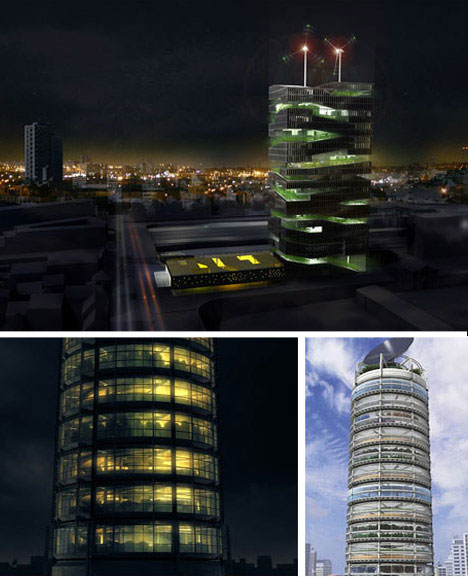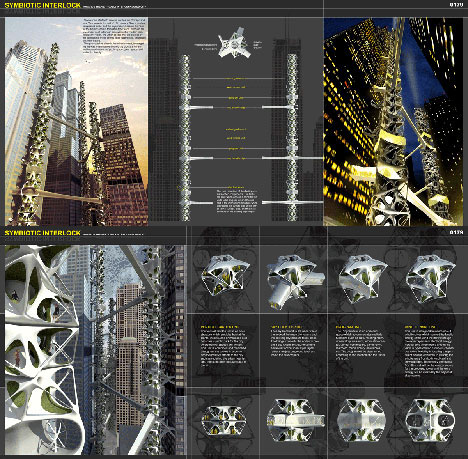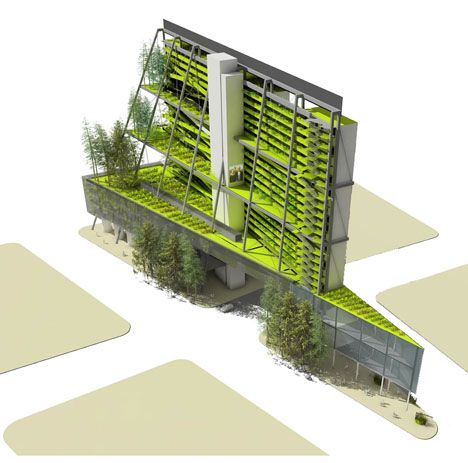- Back to Home »
- AMAZING Design , Architectural DESIGN , GREEN ART and DESIGN »
- GREEN Art, Architecture, Design and Tec 2
 GREEN Art, Architecture, Design and Tec 2
GREEN Art, Architecture, Design and Tec 2
Going green has gone mainstream and with its newfound popularity has come a surge of interest followed by some amazing innovations. From strange green vehicles to creative green roofs, there is no shortage of sustainable design in contemporary society. Beyond the practical green, however, there is some whimsy as well to be found in so-called ‘green art’ as well as amazing tree houses and twisted arbosculptures.

7 Wonders of Morden Green Design (and15 more Future Wonders of Green Tecnology It seems like every week there is a new avante garde green technological innovation or a cutting edge design in the works. Some of these are already reality, some are soon to be and many may never see the light of day but all are in awe-inspiring in their own way.
7 Wonders of Morden Green Design
[This article created with generous assistance from Agustin Otegui]
Green architecture comes in many forms though lately it seems like these forms are stranger than ever. Urban skyscraper farms? Floating eco-cities? Glowing solar towers? Turbine-driven skyscrapers? Magnetically levitated wind collectors? Where does it end?! With all of these emerging green technologies it seemed an appropriate time to take a look at seven of the most amazing real and conceptual designs currently at the forefront of ecological innovation. These examples push the limits of ecological architecture and contemporary urban design discourse.

The so-called Lilypad Project is perhaps the most fantastical of these green wonders and certainly the farthest from being built but is too amazing a concept not to mention. The idea is to create a series of floating self-sufficient ocean-going eco-city islands. Each one would be able to house 50,000 residents and would support a great deal of biodiversity. Collecting pools located in their centers would gather and filter water for use on board. These would be places for adventurers and refugees alike as water levels rise around the world and threaten many, particularly island, habitats.

The most impressive feature of the new Bahrain World Trade Center is, no doubt, the three massive wind turbines situated between the two towers comprising the main building. Each of these 80-foot turbines projects from a bridge between towers. The shape of the towers themselves channels and accelerates air moving between them which will help the building generate even more power. It is by far the largest wind-powered design incorporated into a massive building project to date.

The MagLev Wind Turbine is a big step forward in the world of wind power. By using magnetism to levitate the blades friction is eliminated and more power can be produced without any additional power expense (since the magnetics require no energy to run). The Mag Lev has a low threshold velocity for producing energy, could theoretically survive for centuries and can power up to 750,000 homes. Though the initial investment involved hundreds of millions of dollars the payoff is potentially huge.

This glowing solar tower looks like something straight out of the Bible. Glowing bright white it sticks out like a sore (giant’s) thumb in the middle of the rolling countryside in Spain. So what is it? Well, it is Europe’s first commercial power station to harness the energy of the sun. How does it work? The sun’s rays are all directed at a single point of the tower and turn water at that point into steam. The steam in turn moves through turbines and generates energy. A strange but very functional process.

Urban Skyscraper Farms
Urban Skyscraper Farms are still purely conceptual for now but are amazing theoretical propositions. They would provide locally grown food in densely packed urban centers. Some such designs incorporate elaborate rainwater reuse systems and other sustainable strategies intended to minimize their environmental impact and maximize their productivity. However, they are massive in scale and would cost a great deal to build. This huge initial outlay is part of what is keeping them out of production.

One of the first designs of its kind, the compelling vertical farm project above was undertaken by Chris Jacobs in cooperation with the grandfather of skyscraper farm concepts: Dr. Dickson Despommier of Columbia University. His ideal: all-in-one eco-towers would be actually produce more energy, water (via condensation/purification) and food than their occupants would consume. His mission: to gather architects, engineers, economists and urban planners to develop a sustainable and high-tech wonder of ecological engineering.




Given that most urban cores are already densely built, one designer has proposed an auxiliary series of structures to be attached to existing structures in downtown areas. These modular constructions would provide garden and recreation spaces for residents as well as light and air filters for the adjacent buildings. In some cases, these retrofits could even provide structural stability to aged buildings and prevent the need to tear them down. Architecturally, these modular units stand out and add another layer to the visual hierarchy of the cities around them.



The Pacific Northwest regional architecture firm Mithun developed a compelling vertical farm building design to incorporate various green building strategies in a mixed-use residential and commercial complexdesigned for downtown Seattle. The concept? Simply put, the structure is designed as a kind of built organism - completely self-sufficient and adaptive to its surroundings. The design includes water and energy self-sufficiency from rainwater and gray water collection and reuse, solar cells, vegetable and grain growing spaces and even a chicken farm - all built on a small-footprint downtown urban lot.


Architect Gordon Graff may succeed in the more green and progressive city of Toronto with his plans for a sky farm with 48 floors and millions of square feet of floor space (and even more growing space). This building, if constructed, will be able to feed tens of thousands of people per year. Best of all, particularly in Canada, the success of the building’s crops isn’t contingent upon climactic conditions. As an architectural and urban design gesture this structure both fits into the city skyline and differentiates itself with simple layers of green.

Depending on your point of view Las Vegas might be the first or it could be the last place you’d imagine the 30-story world’s first vertical farm. Of course, the food isn’t going to feed the famished masses. It will instead grace the dinner plates of Vegas tourists at local casinos and hotels. Still, as a prototype it has a lot of potential to generate further buzz and interest that could in turn lead to future projects. If the model proves both profitable and sustainable (always the best combination) it will likely (and hopefully) be the first of many.

The Dongtan Eco-City is designed to be the world’s first not only an environmentally but also a “socially, economically and culturally” sustainable city. The site is over 50 square miles in size and will be split between agricultural and urban areas. The city relies on its own wind and solar energy as well as organic farming strategies. Public transportation will be entirely emissions free. In many ways this is a prototype for large-scale city planning within a fully eco-friendly mindset.

The so-called Lighthouse skyscraper is a 1000-foot-tall office skyscraper that is designed to use about half the water and energy of a typical high-rise building. The tower design employs solar energy collection and wind farming techniques coupled with strategies to reduce the use of and improve recovery of energy and water within the building. If/when built, this building will be a kind of working prototype for future green design in massive urban construction.

While these projects are extremely impressive in terms of their scope, scale and innovation many of them are expensive and difficult to replicate. They are, in short, large-scale solutions to a pervasive problem that exists on all scales with respect to sustainability in design. So what is the answer? Well, some designers have come up with alternatives that are meant to work at varying scales and within more limited budgets. Agustin Otegui’s Nano Vent-Skin is a perfect example.
What is it? In short it is a structure that acts like a skin. It is composed of mini wind turbines made out of micro organisms which generate energy from wind and sunlight. NVS was born as a small scale alternative after seeing all the gigantic projects (like those mentioned above) being built around the world. Where it seems that in order to be green you have to think big and build something impressively huge. This concept tries to make Architects and Designers think on a smaller scale and apply it to existing buildings, houses and structures or even tunnels and barriers to generate energy.

8 Great Green Roofs:
How would you like to have a goat feeding on your roof? Whether useful for shock value and tourist trade or for sustainability and energy reasons, green roofs are on the rise around the world. Here are some examples that range from small to large, intensive to extensive.

In Scandanavia green roofs are nothing new and green roofed architecture dates back centuries. Residential and farm structures used simple grass-covered green roofs primarily to absorb rainfall and provide thermal protection. There are even some contemporary buildings set in vernacular styles, such as this liquor store, that employ semi-traditional green roofs.

This Kelsey-Hayes Corporation bomb shelter design incorporates a green roof a hobbit would feel right at home in. This green roof design engage the structure aesthetically with the landscape, keeps the structure cool and even shrouds it from view in case of air attack. A dated approach to be sure, but also a compelling prefab idea that is results in something quite different from traditional suburbia.


Speaking of Hobbit holes, Pembrokeshire, Wales is home to a family with a house straight out of this classic fantasy tale. This amazing architectural wonder is created virtually completely from the natural materials found around the residence. The walls are made out of stone and mud and water enters the house by gravity from a nearby spring, and the roof is entirely green.

The idea of goats on a green roof might also seem fantastical or antiquated, but has likewise become a modern-day reality in Wisconsin. Sure, there is an element of whimsy and tourist-baiting to this design but it is also quite practical both for the maintenance of the roof as well as for the health (and perhaps entertainment) of the goats.

More contemporary green roof strategies are in many cases correspondingly more ambitious. Take this Japanese green roof for example, that sits on a massive building containing offices, retail space, a theater and a museum. The roof itself features over 30,000 plants of over 70 different species and brings usable green space to a dense urban core.

The Hundertwasser building is another great example of a contemporary green roof that is as impressive as the architecture below it is bizarre. The Waldspirale (or “forest spiral”) features over 100 apartments and wraps around a shared landscaped courtyard space with an actual flowing stream. The irregular forms and vibrant colors reflect the interests of the architect, who was both a designer and a painter.


When it is finished, the Vancouver Exhibition Center will have the largest green roof in Canada. This building is extremely aggressive in its environmental undertakings, with greywater treatment, energy efficient lighting and other strategies. Even the footings sunk into the water below it will foster the growth of marine life. In terms of style and ambition, this project is set to outdo the largest green roof in the world, a Ford Plant in Michigan. Want more green? See related articles on Bizarre Green Art and Creative Guerilla Gardening
To be Continued...











Post a Comment